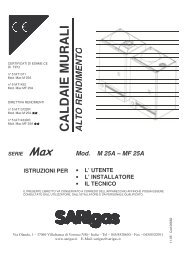EcoTop ETF-ETFL-ETFW Manuale Utente Rev.09-06 GB - Sarigas
EcoTop ETF-ETFL-ETFW Manuale Utente Rev.09-06 GB - Sarigas
EcoTop ETF-ETFL-ETFW Manuale Utente Rev.09-06 GB - Sarigas
Create successful ePaper yourself
Turn your PDF publications into a flip-book with our unique Google optimized e-Paper software.
STARTING UP THE BOILERIGNITION OF THE MAIN BURNER (Fig. 1)- Check that the water pressure to the system is 1 bar (pressure gauge F, Fig. 1). If the pressure is below 0.7 bar, fill the boileragain through the filling valve Fig.23/B.- If the gas tap is installed, check it is open.- Turn off the electric bipolar supply switch to the boiler, which is fitted on the outside of the appliance.- Turn knob A to position I.- The boiler is now ready to work normally. Main burner ignition is controlled by the boiler thermostat and/or the room thermostat inthe WINTER programme, or by the drawing off hot water.WORKINGMaximum water supply temperature is strictly connected todemanded water load and water temperature at intake.Fig.2 represents maximum water supply temperature given awater intake temperature of 15°C.Rev.0Fig.2Summer position DOMESTIC HOT WATER ONLY PROGRAMME- Turn knob “B” to SUMMER programme- Turn on any hot water taps.- When hot water demand exceed 2.8 l./min., the boiler automatically gets ready to produce hot water.- Turn the temperature setting knob A to the desired temperature.- Mixing hot water with cold is not recommended, it is preferable to adjust desired supply temperature directly on appliance.“Comfort Programme” PositionTHIS PROGRAMME IS DESIGNED TO MAINTAIN BOILER DOMESTIC HOT WATER CIRCUITUP TO TEMPERATURE.- Turn knob “B” to programme; verify that the indicator "D" Fig.1 is flashing with intermittence for about 40seconds; automatically also in absence of drawing of water, the boiler with short cycles of turning the power onand off will maintain the sanitary water temperature contained in boiler; the function of maintenance of the internaltemperature at the boiler will remain active for the following 60 minutes after the last drawing. To each newfollowing drawing the function will be restored automatically.Winter position HEATING PROGRAMME- Turn knob “B” to WINTER position, if room thermostat is not fitted turn knop “B” to desired temperature- If the system has a room thermostat fitted, it must be adjusted to the maximum temperature setting.The burner fires automatically and the heating cycle starts up.Set the room thermostat to the desired temperature.- If external probe (optional) is fitted, turn knob “B” to a value between 1 and 9. Once maximum room temperature hasbeen reached, turn knob “B” until desired temperature has been reached. From this moment on the heating systemtemperature will vary according to external temperature. A room thermostat is nevertheless recommended in order toreduce gas consumption and improve comfort.SHUTTING OFFFor short winter periods (12 – 24 hours) Turn the selector switch “A” to the position “O”.For long winter periodsBoilers <strong>ETF</strong> / <strong>ETF</strong>L / <strong>ETF</strong>Ware equipped with a “automatic 2 level alarm antifreeze protection system” both on theheating circuit and on the internal domestic hot water circuit, the one on the heating circuit turns on at temperatures below 5°Cand the one on the D.H.W. circuit turns on at below 3°C.These functions are activated at the low temperature recorded on the water internal circuits of the boiler, the circulation pumpaloneor the circulation pump together with the gas burner, provided the boiler is electrically powered and knob “A” Fig.1 is turned to ”1”position. Once 7°C and 35°C temperatures have been reached in the heating circuit, antifreeze system shuts off automatically. Itis good practice, however, to protect the heating circuit with a suitable, specific chemical additive (antifreeze).If the system is not protected with antifreeze, and the gas valves must be turned off upstream and the electrical supplyto the boiler turned off, empty the heating and the domestic hot water circuits to avoid damage to the variouscomponents, the heating system (pipes, radiators, etc.) and the hot and cold water supply pipes.SARIgas <strong>ETF</strong> / <strong>ETF</strong>L / <strong>ETF</strong>W Page 5



